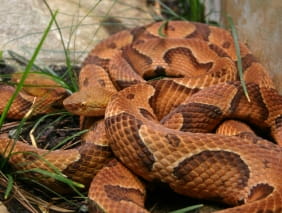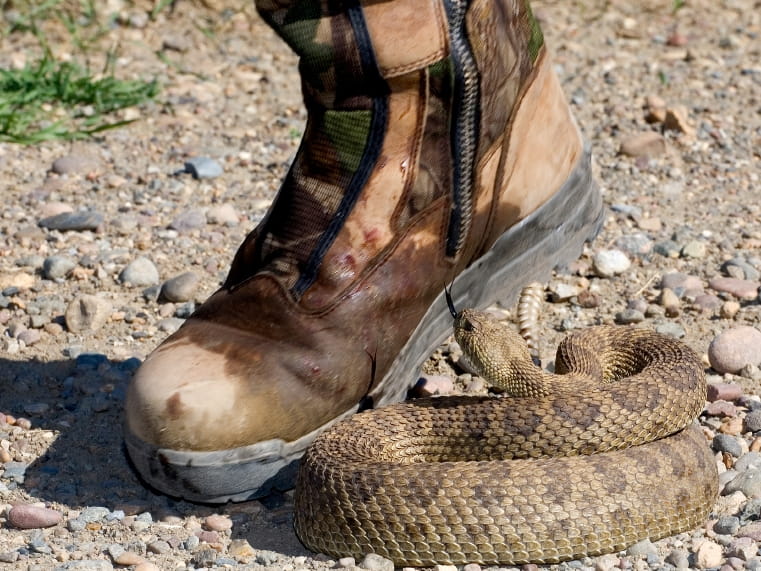Everything You Need to Know About Snakebites

The Bottom Line
The beginning of warmer weather is the beginning of snakebite season. Many of these bites occur around people's homes, but bites can occur anywhere. While there are several species of venomous snakes in the United States, the majority of domestic snakes are not venomous. Be sure to call Poison Control or seek medical attention if someone is bitten.

Why do snakes bite people?
The beginning of warmer weather is the beginning of snakebite season – usually much sooner than people expect, particularly with the effects of climate change. Many of these bites occur around people's homes or when out in nature. People are also sometimes bitten when handling their pet snake or if they work in a zoo or aquarium. Snakes bite because of a perceived threat in their environment.How can you tell if a snake is venomous?
Unless you are familiar with snakes, it can sometimes be hard to tell if a snake is venomous. Rattlesnakes have rattles, which can help identify them. Other characteristics are a little harder. For example, it is said that venomous snakes have triangularly shaped heads. However, many non-venomous snakes flatten their heads so that they appear more triangular when they feel threatened. What’s more, adages about stripe patterns (“Red touch yellow, kills a fellow. Red touch black, venom lack.”) are not always reliable.
What US snakes are venomous?
There are two major types of venomous snakes in the United States: pit vipers and elapids. Pit vipers include rattlesnakes, cottonmouths (water moccasins), and copperheads. They are called pit vipers due to the heat-sensing pits on their face. There are many different types of rattlesnakes in the US, and rattlesnakes have the most potent venom of domestic snakes. Cottonmouths or water moccasins are semi-aquatic snakes, which means they live near the water. When they open their mouths, they have a white cotton-like appearance. Copper heads have a copper color to their scales. Their venom generally causes less severe side effects than rattlesnakes or cottonmouths. Coral snakes are in the elapid family. While they are also venomous, they do not have fangs like pit vipers do. You may not see obvious puncture marks, however venom can still enter your body. Coral snake venom can affect nerves, causing muscle weakness and paralysis.What symptoms occur if you are bitten by a venomous snake?
The symptoms you experience following a venomous snake bite will vary depending on the snake involved and where on the body the bite occurred. The most common symptoms are pain and swelling of the area around the bite. In some cases, the swelling can spread rapidly. Other symptoms include abnormal blood counts, particularly of platelets. If the venom affects the nerves, you can see muscle weakness and paralysis. Some people have an allergic-type reaction to the venom, which can cause airway swelling, low blood pressure, and trouble breathing.How can you prevent snake bites?
Remember that snakes would rather leave you alone than bite you. Pay attention to where you walk and look before you reach or grab something hidden. Turn on the lights if it's dark. Wear shoes when you go outdoors. In many snakebite cases, people were bitten when they went outdoors in bare feet or sandals, often in the dark. If you see a snake, do not try to go after it, as this can result in a bite. If needed, there are professionals that can help relocate snakes.
What should you do for a snakebite?
If someone is bitten by a snake:
- Don’t panic. Many snakes are not venomous and snakebites can be treated. Depending on the snake involved, bites are generally less dangerous than many people assume.
- Don’t risk another bite by trying to capture or kill the snake. If you can take a picture or describe the snake, that can be helpful, but not essential.
- Don’t use old first aid remedies: no tourniquets, ice, or cutting the wound and sucking out the venom. None of these "treatments" help and most of them make things worse.
- Do keep the person quiet and still.
- Do keep the arm or leg (usual sites for snakebite) at the level of the heart.
- Do remove any jewelry, watches, and tight clothing from the area of the bite.
- Do wash the area gently with soap and water.
If someone is bitten by a snake, help from experts is available by phone at 1-800-222-1222. Poison Control’s expert guidance is always free, confidential, and available 24 hours a day. They can help you figure out if the bite is from a venomous or non-venomous snake. They will tell you what to do next, based on the information available and your symptoms.
How are snake bites treated?
If you are bitten by a venomous snake and you develop symptoms, antivenom is available for domestic snakes. If you need antivenin, Poison Control will work with hospital staff to be sure you get the right amount. Wound care, tetanus update, and pain control are also part of treatment. In some cases, Poison Control will follow the patient’s blood count, as some snake venom can affect platelets and clotting factors. Deaths are exceedingly rare from snake bites in the United States, but limb swelling can last for weeks after a bite.
Rose Ann Gould Soloway, RN, BSN, MSEd, DABAT emerita
Clinical Toxicologist
Revised Maryann Amirshahi, PharmD, MD, MPH, PhD
Medical Toxicologist
Poison Control Media Information
Did you find this page helpful? If so, we need your support. Poison Control is in constant competition with misinformation online. Links to www.poison.org or our webPOISONCONTROL triage tool from other websites and blogs help internet searchers quickly find accurate information and Poison Control’s contact information in an emergency. If you use the content from this page, please provide attribution via a link back to this page, www.poison.org, or https://triage.webpoisoncontrol.org/#!/exclusions. By doing so, you could save a life. Thank you!
Poisoned?
Call 1-800-222-1222 or
Prevention Tips
- Remember that snakes would rather leave you alone. Walk away and do not provoke them.
- Look where you walk and look before you reach or grab something hidden. Turn on the lights if it's dark.
- Wear shoes when you go outdoors, as bites commonly occur in people walking barefoot.
This Really Happened
Case 1. A 17-month-old girl was in her family's garage, where she was bitten by a copperhead snake on the top of her foot. When she got to the emergency room, her foot and ankle were swollen and bruised. She was given antivenin but the swelling continued. Within 10 hours, the swelling was up to her groin; it was causing pressure on muscle tissue in her leg. Additional antivenin was given, to a total of 26 vials during her treatment. She also received pain medication. The swelling began to recede. By the fourth day in the hospital, the child was able to walk and was discharged. Two weeks later, the child's skin looked normal and she was back to her normal level of activity.
Case 2. A 25-year-old woman was bitten on her ankle by a copperhead snake in mid-April while walking down some steps toward a creek in suburban Washington, D.C. She presented to the nearest emergency room within 20 minutes. The emergency physician consulted Poison Control for treatment information. The patient was given wound care, a tetanus shot, and medication for anxiety and pain. She did not develop any swelling at the bite site and was discharged to home after 6 hours of observation. In a follow-up call from Poison Control 24-hours later, the patient reported that she was fine. She stated that the bite had gone through her jeans and she suspected that it was a dry bite.
For More Information
References
Quan D. North American poisonous bites and stings. Crit Care Clin. 2012;28:633–659.
Poisoned?
Call 1-800-222-1222 or
Prevention Tips
- Remember that snakes would rather leave you alone. Walk away and do not provoke them.
- Look where you walk and look before you reach or grab something hidden. Turn on the lights if it's dark.
- Wear shoes when you go outdoors, as bites commonly occur in people walking barefoot.
This Really Happened
Case 1. A 17-month-old girl was in her family's garage, where she was bitten by a copperhead snake on the top of her foot. When she got to the emergency room, her foot and ankle were swollen and bruised. She was given antivenin but the swelling continued. Within 10 hours, the swelling was up to her groin; it was causing pressure on muscle tissue in her leg. Additional antivenin was given, to a total of 26 vials during her treatment. She also received pain medication. The swelling began to recede. By the fourth day in the hospital, the child was able to walk and was discharged. Two weeks later, the child's skin looked normal and she was back to her normal level of activity.
Case 2. A 25-year-old woman was bitten on her ankle by a copperhead snake in mid-April while walking down some steps toward a creek in suburban Washington, D.C. She presented to the nearest emergency room within 20 minutes. The emergency physician consulted Poison Control for treatment information. The patient was given wound care, a tetanus shot, and medication for anxiety and pain. She did not develop any swelling at the bite site and was discharged to home after 6 hours of observation. In a follow-up call from Poison Control 24-hours later, the patient reported that she was fine. She stated that the bite had gone through her jeans and she suspected that it was a dry bite.
